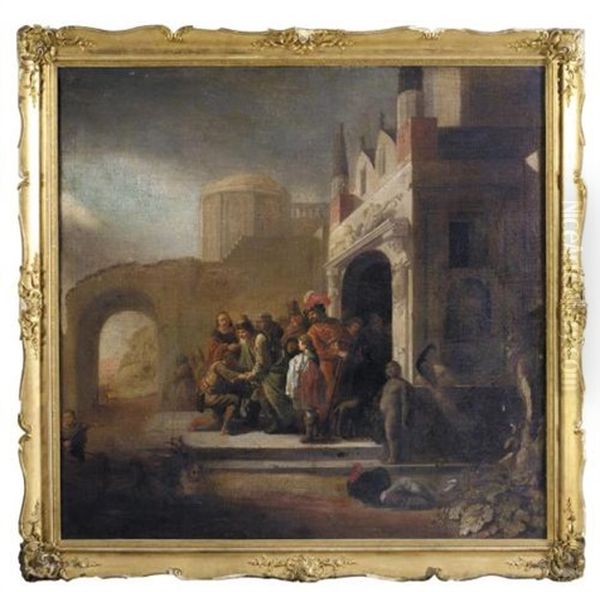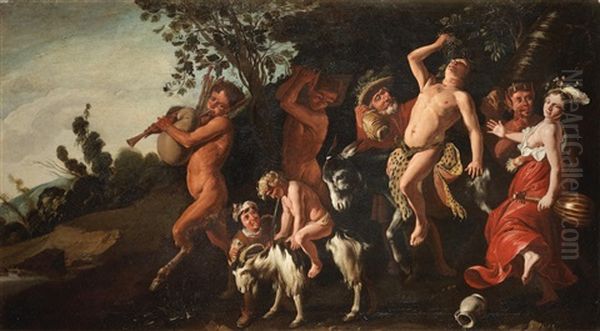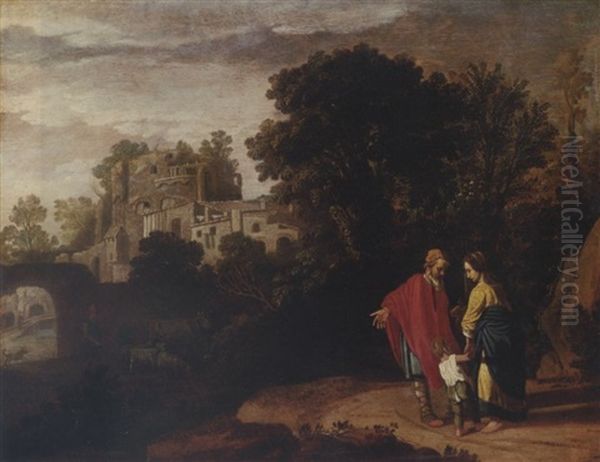Claes Cornelisz Moeyaert stands as a significant, albeit sometimes overlooked, figure in the rich tapestry of the Dutch Golden Age. Active primarily in Amsterdam during the first half of the 17th century, Moeyaert was a versatile artist known for his historical, biblical, and mythological paintings, as well as his contributions to portraiture and landscape. As a prominent Catholic painter in a predominantly Protestant city, and a key member of the group often referred to as the "Pre-Rembrandtists," his life and work offer valuable insights into the artistic and cultural dynamics of his time. His career, spanning roughly from the 1620s until his death in 1655, places him at the heart of a transformative period in Dutch art.
Early Life and Artistic Beginnings
Claes Cornelisz Moeyaert was born around 1590 or 1591, likely in Durgerdam, a village just outside Amsterdam. While details of his earliest training remain somewhat obscure, it is believed he came from a relatively affluent Catholic family. Some art historians suggest that, like many aspiring artists of his generation, Moeyaert may have travelled to Italy in his youth to study the masters of the Italian Renaissance and Baroque, although definitive proof of such a journey is lacking. What is certain is that he established himself in Amsterdam, the bustling economic and cultural hub of the Dutch Republic.
By 1617, Moeyaert was settled enough in Amsterdam to marry Griet Claes. The couple would go on to have three children. Tragically, family life was marked by difficulty, as two of their children were known to have suffered from intellectual disabilities. Despite these personal challenges, Moeyaert's artistic reputation began to grow. An early sign of his recognition came in 1618 when the poet Carden van Roden praised his talent, indicating that Moeyaert was already making a name for himself within Amsterdam's artistic circles even before his dated works confirm his activity from 1624 onwards.
The Pre-Rembrandtist Context and Key Influences

Moeyaert is critically positioned within the group known as the Pre-Rembrandtists. This term refers to a circle of Amsterdam painters active in the decades preceding Rembrandt van Rijn's rise to dominance, whose work often shared stylistic similarities, particularly a focus on dramatic historical and biblical narratives influenced by Italian art, yet executed with a distinct Dutch sensibility. The most significant figure in this context for Moeyaert was undoubtedly Pieter Lastman.
Pieter Lastman, who famously taught both Rembrandt and Jan Lievens, was a leading history painter in Amsterdam upon his return from Italy. Moeyaert's work shows a clear affinity with Lastman's style, characterized by lively compositions, rich colours, expressive figures, and attention to detail in costumes and settings. It is even suggested that Moeyaert may have had business dealings with Lastman, possibly sharing studio space or collaborating in the bustling art market located around the Sint Antoniesbreestraat, where both artists lived and worked for periods.
While Lastman's influence is paramount, Moeyaert's work also occasionally echoes the grandeur and dynamism associated with the Flemish master Peter Paul Rubens, particularly in his handling of complex figure groups and dramatic lighting. However, Moeyaert adapted these influences into his own, often more restrained and intimate, Dutch style. He developed a distinctive technique, becoming known for his skilled use of red chalk or red lead pigment, both in preparatory drawings and sometimes as underlayers or accents in his paintings, contributing to the warmth and vibrancy of his palette.
Artistic Style and Thematic Focus
Moeyaert's artistic output was diverse, but his reputation primarily rests on his history paintings – scenes drawn from the Bible (especially the Old Testament), classical mythology, and ancient history. He approached these subjects with a narrative clarity and emotional depth that appealed to the tastes of Amsterdam's patrons, who valued didactic and morally resonant art. His compositions are often carefully structured, sometimes employing symmetrical arrangements to create a sense of order and gravity, while at other times using dynamic diagonals and contrasting light and shadow (chiaroscuro) to heighten the drama.
His figures are typically robust and expressive, conveying emotion through gesture and facial expression. Moeyaert paid considerable attention to rendering textures, fabrics, and architectural details, grounding his historical and mythological scenes in a tangible reality. Unlike the later, more introspective works of Rembrandt, Moeyaert's paintings often retain a certain clarity of outline and a brighter, more varied palette, reflecting the earlier Baroque trends prevalent in Amsterdam during the 1620s and 1630s. His use of red pigments often lends a characteristic warmth to his flesh tones and draperies.
Representative Works and Major Commissions

Moeyaert's oeuvre includes numerous significant works that exemplify his style and thematic interests. His documented career, traceable through dated paintings, begins around 1624. One of his most high-profile commissions came in 1638 when he was chosen to design one of the triumphal arches erected in Amsterdam to celebrate the official visit of the French Queen Mother, Maria de' Medici. This event was a major civic occasion, and Moeyaert's contribution underscores his standing as a respected artist capable of undertaking large-scale public works. His design, likely depicting allegorical or historical scenes relevant to the occasion, was part of the elaborate decorations for the procession held on September 1st, 1638.
Biblical narratives form the core of his surviving work. Paintings like Joseph Selling Corn to the People (1637, also known as Joseph Selling Corn in Egypt) and The Meeting of Jacob and Joseph in Egypt showcase his ability to handle complex multi-figure compositions and convey dramatic moments from the Old Testament. These stories, emphasizing themes of providence, family reunion, and leadership, resonated strongly with Dutch audiences. Other notable biblical works include The Supper at Emmaus and Ruth and Boas, demonstrating his engagement with both Old and New Testament subjects.
Mythological themes also feature prominently. Works depicting classical myths allowed Moeyaert to explore dramatic narratives and often involved the depiction of the nude or semi-nude figure, showcasing his academic skills. Iphigenia and Orestes in Tauris is one such example, though this particular painting has also been the subject of art historical discussion regarding later alterations. Another intriguing work is Hippocrates and Democritus, depicting the legendary encounter between the physician and the philosopher, a subject that invites contemplation on themes of wisdom, madness, and the nature of humanity.
Connections within the Amsterdam Art World
Moeyaert was well-integrated into the artistic and social fabric of Amsterdam. His connections extended beyond his presumed relationship with Pieter Lastman. He maintained a significant business relationship with Hendrick van Uylenburgh, one of the most influential art dealers in Amsterdam during the period. Van Uylenburgh operated a large workshop and dealership, employing many artists and facilitating commissions. Notably, Hendrick van Uylenburgh was the cousin of Saskia van Uylenburgh, who would marry Rembrandt in 1634. This connection places Moeyaert firmly within the orbit of the city's leading artistic network.
Beyond his painting activities, Moeyaert was involved in the cultural life of the city. He served as a commissioner or trustee for the Amsterdam Theatre (Schouwburg), indicating a level of civic engagement and respect within the community. This role likely brought him into contact with playwrights, poets, and other cultural figures.

Moeyaert also played a role as a teacher, passing on his skills and style to the next generation. Among his known pupils are several artists who achieved considerable fame in their own right: Nicolaes Berchem, who became a celebrated painter of Italianate landscapes; Salomon Koninck, known for his history paintings and portraits often reminiscent of Rembrandt's style; and Jan Baptist Weenix, another versatile artist known for landscapes, portraits, and still lifes. The success of his students further attests to Moeyaert's capabilities as an artist and instructor.
He is often categorized alongside other "native" Amsterdam painters of his generation, such as Adriaen van Nieulandt and Isaac Isaacz, artists who, while respected, are sometimes seen as representing a slightly more conservative or locally-focused trend compared to the more internationally oriented styles or the groundbreaking innovations of Rembrandt. Other contemporaries in the vibrant Amsterdam scene included figures like Jacob Pynas, another Pre-Rembrandtist with links to Italy.
Art Historical Evaluation, Controversies, and Mysteries
In art history, Claes Cornelisz Moeyaert is recognized as a key representative of the early Dutch Baroque style in Amsterdam. He successfully blended influences from Italian art, particularly via Pieter Lastman, with local Dutch traditions. His work provides a crucial link between the earlier generation of history painters and the towering figure of Rembrandt. While perhaps not possessing the revolutionary genius of Rembrandt or the international fame of Rubens, Moeyaert was a highly skilled, productive, and influential artist within his context.
His legacy is not without its complexities and points of discussion. The painting Iphigenia and Orestes in Tauris, for instance, has been subject to scrutiny due to evidence of later alterations. Reports suggest that elements like a sacrificial ram may have been painted over or replaced, and other figures, possibly Moorish attendants, added, raising questions about the painting's original appearance and the history of its ownership and restoration. Such interventions complicate the study of the artist's original intentions.
Another minor controversy, or rather a testament to the shifting tides of attribution, involves his Joseph Selling Corn in Egypt. During the 19th century, this painting was apparently misattributed to another artist, only later being correctly identified as a work by Moeyaert. This highlights the challenges art historians sometimes face in definitively assigning works from this period, especially for artists whose styles might share characteristics with contemporaries.

Certain aspects of his work remain enigmatic. The precise philosophical message or allegorical intent behind Hippocrates and Democritus, for example, continues to be debated by scholars. The existence of lost works, such as a painting mentioned by his student Nicolaes Berchem but no longer traceable, adds another layer of mystery to fully comprehending his complete artistic output. His devout Catholicism in a city that was officially Protestant also adds an interesting dimension to his career, suggesting a degree of religious tolerance or patronage networks that crossed confessional lines.
Conclusion: Moeyaert's Enduring Place
Claes Cornelisz Moeyaert died in Amsterdam in 1655, leaving behind a substantial body of work that reflects the artistic dynamism of the Dutch Golden Age. He navigated the complex influences of Italian art, the legacy of Pieter Lastman, and the rising prominence of Rembrandt, carving out his own distinct artistic identity. As a respected Catholic painter, history painter, teacher, and active member of Amsterdam's cultural scene, he played a multifaceted role.
His paintings, characterized by their narrative focus, skilled composition, expressive figures, and often warm palette enriched by the use of red pigments, offer a valuable window into the tastes and values of his time. While sometimes overshadowed by his most famous contemporaries, Moeyaert remains a pivotal figure for understanding the development of Dutch painting in the crucial decades of the early 17th century. His connections to key figures like Lastman, Rembrandt (indirectly via Uylenburgh and Lastman), and his successful students like Berchem and Koninck, solidify his importance within the network of Dutch Golden Age masters. The enduring appeal of his biblical and mythological scenes, coupled with the occasional mystery and controversy surrounding his works, ensures his continued relevance for art historians and enthusiasts alike.